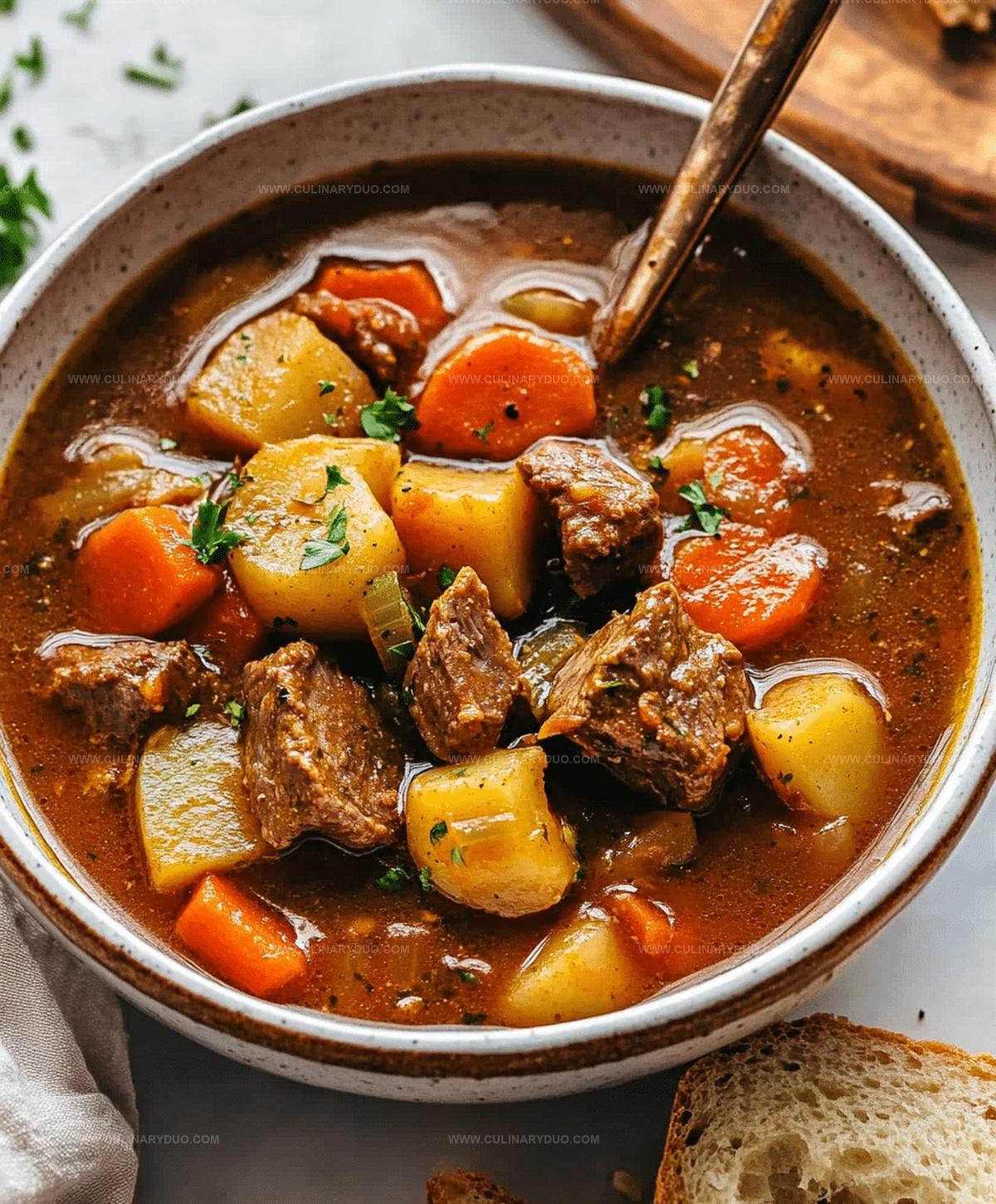The Cozy Old Fashioned Beef Stew Recipe Everyone Loves
Hearty and rich beef stew transports you straight to comfort food heaven with its deep, warming flavors.
Cold winter nights call for this classic homemade beef stew recipe that simmers with tender meat and robust vegetables.
Generations of home cooks have perfected this rustic dish, passing down techniques that create mouthwatering depth and complexity.
Slow-cooked chunks of beef melt into a thick, savory broth that hugs every vegetable with incredible richness.
Each spoonful promises pure, nostalgic satisfaction that connects you to traditional home cooking.
The aroma alone will draw everyone to the kitchen, eagerly anticipating a bowl of pure deliciousness.
This stew isn’t just a meal, it’s a warm embrace on a chilly evening that promises comfort in every bite.
Classic Stew to Warm Up Any Evening
Everything You Need for Old Fashioned Beef Stew
Main Ingredients:Vegetables and Aromatics:Seasonings and Flavor Enhancers:Beef Stew Directions for Cozy Results
Step 1: Prepare Beef
Coat beef cubes generously with salt and pepper, then lightly dust with flour, ensuring each piece is evenly covered.
Step 2: Brown Meat
Heat olive oil in a large pot over medium-high heat.
Carefully brown beef pieces on all sides, creating a rich golden crust.
Work in small batches to prevent overcrowding.
Transfer browned meat to a separate plate.
Step 3: Sauté Aromatics
In the same pot, add chopped onions and minced garlic.
Cook until vegetables become soft and translucent, releasing their fragrant flavors.
Step 4: Build Flavor Base
Stir in tomato paste, allowing it to caramelize slightly.
Return browned beef to the pot, mixing thoroughly.
Step 5: Add Liquid and Vegetables
Pour in beef broth and red wine.
Add vegetables:Include bay leaf, thyme, Worcestershire sauce, and balsamic vinegar.
Stir ingredients together and bring to a gentle simmer.
Step 6: Slow Cook
Cover pot and reduce heat.
Let stew simmer slowly for 1½ to 2 hours until beef becomes fork-tender and vegetables are soft.
Step 7: Finish Stew
Stir in frozen peas during the final 10 minutes of cooking.
Step 8: Serve and Garnish
Sprinkle freshly chopped parsley on top before serving.
Enjoy with crusty bread.
Time-Tested Tips for Hearty Beef Stew
Ways to Vary Old Fashioned Beef Stew
Serving Suggestions for Classic Beef Stew
Storage Solutions for Beef Stew Leftovers
FAQs
Coating beef in flour helps create a golden-brown crust that locks in moisture and adds rich flavor to the stew. The flour also helps thicken the sauce naturally during cooking.
Chuck roast or beef stew meat work best because they’re tough cuts that become tender and flavorful after slow cooking. Avoid lean cuts like sirloin, which can dry out and become tough.
Red wine adds depth and complexity to the stew’s flavor, but you can substitute with additional beef broth if you prefer a non-alcoholic version. The stew will still taste delicious.
Print
Old Fashioned Beef Stew Recipe
- Total Time: 2 hours 20 minutes
- Yield: 6 1x
Description
Hearty Old Fashioned Beef Stew delivers comfort straight from grandma’s kitchen, blending tender meat with rich, slow-cooked vegetables. Warm spices and deep flavors create a classic American dish you’ll crave on chilly evenings.
Ingredients
Meat:
- 2 pounds (0.9 kilograms) beef chuck roast, cut into 1–2 inch cubes
Vegetables:
- 1 large onion, diced
- 3 carrots, peeled and cut into 1-inch pieces
- 4 medium potatoes, peeled and cut into chunks
- 2 celery stalks, sliced
- 1 cup frozen peas
- 3 cloves garlic, minced
Liquid and Seasoning:
- 4 cups beef broth (low-sodium)
- 1 cup red wine
- 3 tablespoons olive oil
- 3 tablespoons all-purpose flour
- 2 tablespoons tomato paste
- 1 tablespoon balsamic vinegar
- 1 teaspoon dried thyme
- 1 teaspoon Worcestershire sauce
- 1 bay leaf
- Salt and black pepper, to taste
- Fresh parsley, chopped (for garnish)
Instructions
- Coat beef cubes thoroughly with seasoned flour, ensuring even coverage.
- Sear meat in hot olive oil over medium-high heat, creating a rich golden-brown crust on all surfaces. Work in smaller batches to prevent overcrowding.
- In the same pot, caramelize onions and garlic until translucent and fragrant, releasing their sweet aromatics.
- Incorporate tomato paste, stirring vigorously to develop a deep, concentrated flavor profile.
- Return browned beef to the pot, nestling pieces into the aromatic base.
- Introduce beef broth and optional red wine, creating a rich liquid foundation. Layer in root vegetables, herbs, Worcestershire sauce, and balsamic vinegar for complex depth.
- Reduce heat to low, cover the pot, and allow stew to gently simmer for 1½ to 2 hours. The extended cooking time will tenderize meat and meld flavors.
- During the final 10 minutes, fold in frozen peas to preserve their vibrant color and fresh texture.
- Finish by sprinkling fresh parsley over the stew, adding a bright, herbaceous note before serving.
Notes
- Pat the beef dry before seasoning to ensure perfect browning and develop a rich, caramelized exterior.
- Use chuck roast or stew meat for maximum tenderness and rich flavor, as these cuts have excellent marbling.
- Add a splash of red wine to deepen the stew’s complexity and create a more sophisticated taste profile.
- Consider swapping potatoes with sweet potatoes for a lower-carb alternative that adds a subtle sweetness to the dish.
- Prep Time: 20 minutes
- Cook Time: 2 hours
- Category: Lunch, Dinner
- Method: Simmering
- Cuisine: American
Nutrition
- Serving Size: 6
- Calories: 380 kcal
- Sugar: 4 g
- Sodium: 280 mg
- Fat: 18 g
- Saturated Fat: 5 g
- Unsaturated Fat: 12 g
- Trans Fat: 0.1 g
- Carbohydrates: 22 g
- Fiber: 4 g
- Protein: 34 g
- Cholesterol: 95 mg


Michael Reyes
Founder & Lead Recipe Developer
Expertise
Education
Santa Fe Community College
Michael’s love for cooking runs deep, rooted in the bold, colorful flavors of his New Mexico upbringing.
After earning his Culinary Arts Certificate from Santa Fe Community College, he spent years sharpening his skills in kitchens that celebrated traditional Southwestern and Latin American dishes.
He believes cooking should feel approachable and fun, never complicated. When he’s not stirring up new recipe ideas, Michael’s out hiking scenic trails, chatting with farmers at local markets, or chasing the perfect sunset shot for inspiration.